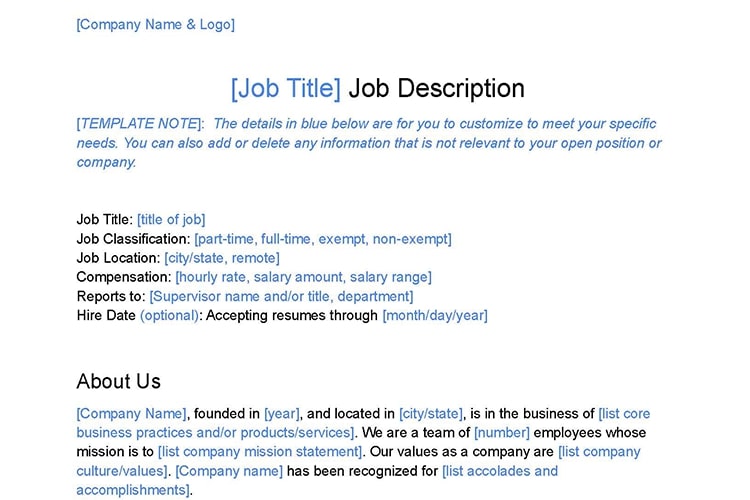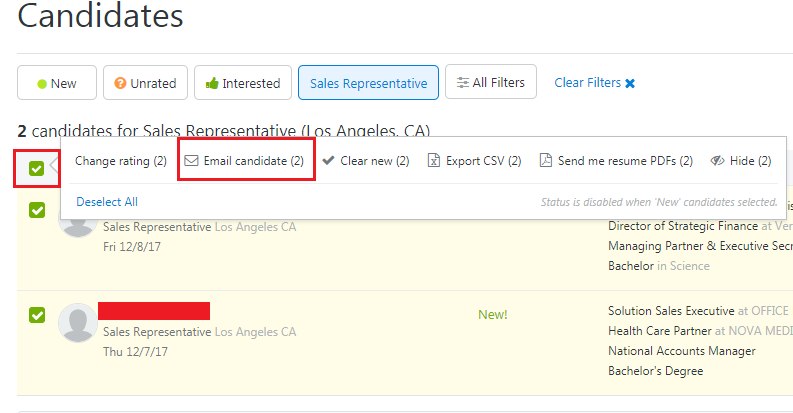Knowing how to hire employees for your small business is the key to growing your company. A good hiring process includes having well-written job descriptions, effective recruitment ads, and a thorough interview process—all of which should promote your culture and values and adhere to fair labor practices.
With AI-powered job matching and sourcing, ZipRecruiter helps you reach the right candidates wherever they are. Besides that, its easy-to-use tools make it simple to manage your entire recruitment process. Try ZipRecruiter today and see the difference it can make in your hiring strategy.
Step 1: Determine the Type of Employee Needed
This step will set the foundation for your hiring process. Before you create the job description, you need to identify the type of employee that you’ll need for the role. There are six types of employee classifications:
- Full-time employees: Employees who work a standard, full workweek, typically around 40 hours per week, with access to benefits and job security.
- Part-time employees: Workers who have a reduced work schedule compared to full-time employees, often with fewer hours and limited benefits.
- Seasonal employees: Hired for a specific period, usually during peak seasons or special events, and their employment ends when the season concludes.
- Temporary employees: Brought in for a short-term assignment, covering leaves of absence, special projects, or workload surges.
- Independent contractors: Self-employed individuals or businesses who provide services to a company as a separate entity, often on a project basis.
- Interns: Students or recent graduates gaining practical work experience in a specific field, typically for a limited duration, sometimes paid or unpaid.
You can get a more detailed description of these employee types in our article, Types of Employees: A Guide to Employee Categories. For tips on how to find the right employee for your business, check out How to Find Employees You’ll Love.
Step 2: Create a Detailed Job Description
The next step in the process of hiring an employee is the job description. A detailed job description helps you connect with qualified applicants as well as clarify work expectations once they are hired. A great job description should include the educational and professional requirements and a preview of the company culture. If you need help in writing a job description, you can read our article on how to write a job description. You can also use our free template to get started.

Thank you for downloading!
Need help crafting a job description?
Consider using ZipRecruiter to help you with all your hiring needs, from crafting a job description to hiring employees.
Include the following in every job description:
Before the duties of the job are discussed, basic information is often shared at the top of the description. For example:
- Company logo
- Job title
- Status (full time, part time, temporary)
- Job location (remote, city/state)
- Salary range
A position summary can be added at the bottom of this section that gives a brief (four to six sentences) description of the position. This is where you let potential candidates know the basics of the position; greater detail can be given further down that outlines specific duties and responsibilities.
This is the area of the job description where you define the job’s duties and responsibilities in specific detail. It is not uncommon to highlight more than 10 primary features of the job, listed in order of importance. The more detailed a picture you paint of the position, the more qualified candidates you will attract.

List the highlighted roles and responsibilities of the position.
Be sure to include all essential functions of the position. These are the duties that an employee must be able to perform, with or without reasonable accommodation. The U.S. Equal Employment Opportunity Commission (EEOC) governs what is considered an essential function, partially through the Americans with Disabilities Act Amendments Act of 2008 (ADAAA).
Some of these functions may include:
- Ability to sit or stand for long periods
- Able to lift a certain amount (i.e., 50 pounds)
- Languages required to be successful
- Required travel
- Ability to use general office equipment
When you create your job description, make sure you’re describing the skills necessary for a candidate to be successful in the role. These may be learned skills, like proficiency in certain computer software, or soft skills, like personal development.
Skills Examples | |
|---|---|
Required Skills
| Soft Skills
|
Most business owners list a minimum educational requirement in their job description based on the job role when hiring employees. For example, a solar installation company may desire its workers to have at least a GED or high school degree to be able to read complex instructions. Meanwhile, a CPA firm might prefer its associates to have a business or accounting degree (bachelor’s or master’s), whereas a Biomed testing facility may need Ph.D. candidates for licensing purposes.
Think about the work experience a candidate must have. In addition to education and training, many skills are learned on the job. More often than not, it is best to clarify what is “required” and what is “preferred” in experience, education, and skills.
Here are some examples of the kind of “experience statements” that you might want to include in your job description:
- Four years of customer service experience in a fast-paced sales environment; two years in IT sales preferred.
- Five years of diesel mechanic experience or two years of experience if ASE certified.
- Ten years in multi-restaurant management or former GM managing at least $100K in sales each month.
- Three years of transportation dispatch experience with temperature-controlled carriers; food service transportation experience preferred.
- Six years of technical or supervisory experience in any construction trade; three years of solar panel installation preferred.
Step 3: Advertise & Recruit
Once you’ve created your job description, it’s time to advertise your job. Many businesses use job boards to find qualified employees and make recruitment easier. Job board services like ZipRecruiter will not only increase visibility and attract top-tier candidates but offer templates to assist you with crafting a job advertisement. Learn more about it in our in-depth ZipRecruiter review.
Click through the tabs below for steps to advertise your job:
Step 4: Evaluate Resumes
Once you begin receiving job applications, you’ll have to screen job applicants to find qualified ones to take to the next step. If you’re using a job posting site like ZipRecruiter, you’ll have access to online tools that assess job applicant qualifications in advance; otherwise, you’ll start by reading applications and resumes to determine which candidates to interview.
Step 5: Interview Candidates
Once you’re done sorting, it’s time to schedule interviews. Be certain you have a good interviewing process established, which should always include more than the hiring manager or the HR representative.
Set up an interview schedule with your top candidates. Although this can be done via email, we suggest doing so through a phone call to assess each job seeker’s interest before committing yourself or your managers to the full interview process. Some applicants may have already accepted a job with another firm, while others may not be as good a fit as they appear to be on paper, so this could be another layer of screening before settling on one candidate.
The most common forms of interviews include:
- Phone Interviews: A phone interview is generally brief. You contact the candidate, thank them for applying, and ask if they would mind answering a few questions. How they react will tell you much about their true interest in the role.
- Video Interviews: Video interviews are great for team interviews (with more than one of your managers) or remote and work-from-home candidates. Don’t worry if you don’t already have video conferencing software, as many are free. Check out some of the best free video conferencing we evaluated to help you get started.
- In-person Interviews: In-person interviews are the most common interview type managers think of when they imagine interviewing a new hire. But in-person interviews are notoriously inefficient and may result in you selecting a candidate based on how similar they are to you (affinity bias) rather than how qualified they are.
A best business practice is to acknowledge those candidates that took the time to apply to your open position. Remember to communicate just as promptly with those who didn’t make the cut as those who did. For those you’re going to be turning down, you can send rejection letters or use a job board, like ZipRecruiter, that will allow you to send bulk emails to candidates, including interview requests and rejection letters.

ZipRecruiter allows you to send emails to multiple candidates at one time.
The best candidate for the job is the individual who most closely fits the job requirements and has the highest likelihood to succeed in the role within your organization. If the candidate will be working in a specific department, it’s recommended for direct supervisors to have a say in which candidate is right for the job.
It’s also a good idea to contact prior employers and check the candidate’s references to get insight into the candidate’s strengths. Take a look at your candidate’s LinkedIn profile to be sure it matches the attributes listed in their resume.
Find out the right questions to ask your job candidate in the 15 Important Reference Check Questions to Ask.
Once you have selected the candidate you want to hire, consider conducting a background check and/or a pre-employment drug screen. A background check can verify a candidate’s employment history, experience, and education, and may shed light on any criminal activity. This is especially important for certain roles, such as finance, accounting, and jobs that include driving.
A background check company, like Checkr, will verify the candidate’s information and report any issues directly to your business. The best companies are compliant with the Fair Credit Reporting Act (FCRA), offer transparent pricing, and provide you with a quick response.
Step 6: Craft a Job Offer
Your final step in hiring a new employee is to write a formal job offer letter. This letter should outline what the role is, when it starts, and what it pays. Additionally, include a benefits statement, contingencies, and an offer timeframe that the candidate must respond by to accept the offer.
When describing your company and the position being offered, make sure the personality and culture of your company come through. Include benefits as well as your company’s unique mission. It’s also a good idea to make the job offer contingent upon a successful background check, required physicals, drug tests, or any other pre-hire requirements.
Don’t be surprised if your job candidate doesn’t accept your first job offer. Be willing to negotiate unless you simply can’t pay a penny more. Many new hires are open to receiving off-site training, getting a few more days of paid time off (PTO), or working remotely in exchange for a lower-than-desired salary.
Post-hire Considerations
Once your new hire has agreed to your job offer, it’s time to plan their onboarding. Additionally, when you take into account recruiting expenses and new employee training costs, retaining good employees is the most profitable way to keep your business fully staffed.
Signs That It’s Time to Hire
You now have the guide on how to hire the right employees for your company, but how do you know it’s time to hire? In small companies with limited staff, it is common for employees to take on several roles, often switching tasks where they are needed. While it’s nice to have flexible and talented employees, such practice can cause burnout. This, in turn, can lead to employees quietly quitting their jobs, becoming disengaged, and less productive.
To prevent this from happening, look out for the following signs. They are also your key indicators that it’s time to hire:
- Customer service is failing
- Employees feel overwhelmed
- Missing goals and deadlines
- Employee turnover rate is increasing
- Higher paid employees do low-level tasks
- Cannot take on new projects
- Overtime costs are increasing
Benefits of Hiring New Employees
Bringing in new people to expand your team offers several benefits, including:
- Increased Productivity: New employees bring fresh energy and ideas to your team, often leading to increased overall productivity and efficiency, helping the company achieve its goals more effectively.
- Diverse Skill Sets: Hiring new employees with diverse backgrounds and skill sets can enhance your team’s capabilities and problem-solving potential, leading to greater innovation and adaptability.
- Reduced Workload: Additional employees can help distribute the workload, preventing burnout and stress among existing staff, which can improve morale and job satisfaction.
- Capacity for Growth: Hiring new employees enables your company to take on more projects and expand, reaching new markets and increasing revenue potential.
- Succession Planning: Bringing in new talent allows for the development of future leaders within the organization, creating a pipeline of talent for key positions and ensuring long-term sustainability.
Hiring Employees Frequently Asked Questions (FAQs)
How do I hire an employee for the first time?
To hire an employee make sure you register as an employer in your state, set up payroll, set up workers’ compensation, and post required labor law posters. Additionally, you will want to post your open position on either a job board or by putting a help wanted sign at your business. From there, conduct interviews and choose the best candidate for the position.
What do you need to hire employees?
When hiring employees be sure you have the necessary employee documentation in place to ensure a seamless employee experience. These documents Include I-9, W-4, and other new hire forms. After that, follow the steps in our guide above to find your first employee.
How to hire employees as a sole proprietor?
Before you start hiring, you need to comply with applicable employment laws and regulations. That begins by applying for an employer identification number (EIN). The federal government requires this from businesses for tax purposes. Next, you need to gather employee documentation (mentioned in the above question). Lastly, make sure that the person you’re hiring is eligible to work in the United States
How to hire employees for free?
There are many ways to hire employees for free. First of all, you can ask the help of family and friends to spread the word that you are hiring. You can also use social media or a free job posting website to advertise your job openings. You might also want to consider offering unpaid internships or volunteer opportunities as a way to assess potential employees’ skills and fit for your organization before making a formal hiring commitment.
Bottom Line
Hiring employees to grow your business and promote your brand is a huge building block in your company’s foundation for sustained success. Take your time to find the person most likely to be successful in the job based on the candidate’s resume, interviews, and employment references. Maintain a clear vision when recruiting and selecting your new team member.
Consider using ZipRecruiter to find your next top employee. It can assist with the entire hiring process—job description templates, job posting to over 100 sites, interviewing, tracking, and hiring. Plus get an exclusive free “Highlight” Enhancement to make your job stand out.